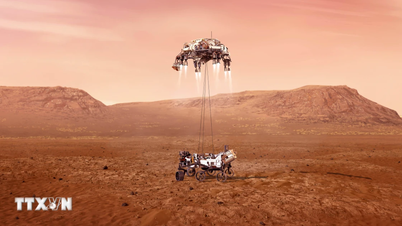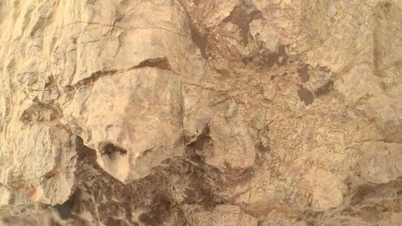According to US media on September 10, dark red sedimentary rock samples formed billions of years ago at the bottom of a lake in Jezero crater, collected by the Perseverance robot, contain minerals that could be signs of ancient microbial life on Mars.
However, scientists note that these minerals can also appear through non-biological processes.
This discovery is considered the clearest evidence yet for the possibility that Earth's neighboring planet once supported life.
“We found a potential biosignature in rocks that formed when Jezero Crater was a watery environment, 3.2-3.8 billion years ago,” said Joel Hurowitz of Stony Brook University, lead author of the study published in the journal Nature.
Acting NASA Administrator Sean Duffy said at a press conference that scientists had been analyzing the data for a year and concluded: “We found no other explanation, so this may be the clearest sign of life we have ever found on Mars – which is really exciting.”
NASA released images of a rusty red, fine-grained mudstone sample with leopard-like rings and poppy-seed-like black streaks, likely formed by a chemical reaction involving microbes.
However, Ms. Nicky Fox, in charge of NASA's Science Directorate, emphasized: "This is not life, but only a sign that may be related to life."
The sample, named Sapphire Canyon, was collected in July 2024 from the Cheyava Falls rock massif of the Bright Angel structure, located on the edge of the ancient river valley of Neretva Vallis.
The researchers identified two main minerals: vivianite (containing iron and phosphorus) and greigite (containing iron and sulfur). On Earth, these minerals typically form when microorganisms consume organic matter in mud and create byproducts.
The rock samples were also rich in organic carbon, sulfur, phosphorus, and oxidized iron—a rich source of energy for microorganisms, according to Hurowitz.
However, he cautioned: “We cannot say with certainty that this is evidence of life because similar chemical reactions can also occur without biology, and the robot's data is not enough to rule out this possibility.”
Scientists believe that bringing the Sapphire Canyon sample back to Earth for study is the only way to verify the hypothesis. However, the “Mars Sample Return” plan is at risk of being canceled due to US President Donald Trump’s current budget proposal. NASA said it is considering alternative options, from direct analysis on Mars to finding faster technology to bring the sample back to Earth./.
Source: https://www.vietnamplus.vn/nasa-phat-hien-dau-hieu-su-song-tren-sao-hoa-gay-chan-dong-gioi-khoa-hoc-post1061143.vnp



![[Photo] Solemn opening of the 8th Congress of the Central Public Security Party Committee, term 2025-2030](https://vphoto.vietnam.vn/thumb/1200x675/vietnam/resource/IMAGE/2025/10/4/f3b00fb779f44979809441a4dac5c7df)

![[Photo] Bustling Mid-Autumn Festival at the Museum of Ethnology](https://vphoto.vietnam.vn/thumb/1200x675/vietnam/resource/IMAGE/2025/10/4/da8d5927734d4ca58e3eced14bc435a3)
![[Photo] General Secretary To Lam attends the 8th Congress of the Central Public Security Party Committee](https://vphoto.vietnam.vn/thumb/1200x675/vietnam/resource/IMAGE/2025/10/4/79fadf490f674dc483794f2d955f6045)














![[INFOGRAPHIC] Ricoh GR IV "Street Warrior" returns](https://vphoto.vietnam.vn/thumb/402x226/vietnam/resource/IMAGE/2025/10/4/253d8aa5753b4d9598a544448f716b47)


































![[VIDEO] Summary of Petrovietnam's 50th Anniversary Ceremony](https://vphoto.vietnam.vn/thumb/402x226/vietnam/resource/IMAGE/2025/10/4/abe133bdb8114793a16d4fe3e5bd0f12)

![[VIDEO] GENERAL SECRETARY TO LAM AWARDS PETROVIETNAM 8 GOLDEN WORDS: "PIONEER - EXCELLENT - SUSTAINABLE - GLOBAL"](https://vphoto.vietnam.vn/thumb/402x226/vietnam/resource/IMAGE/2025/7/23/c2fdb48863e846cfa9fb8e6ea9cf44e7)
































Comment (0)